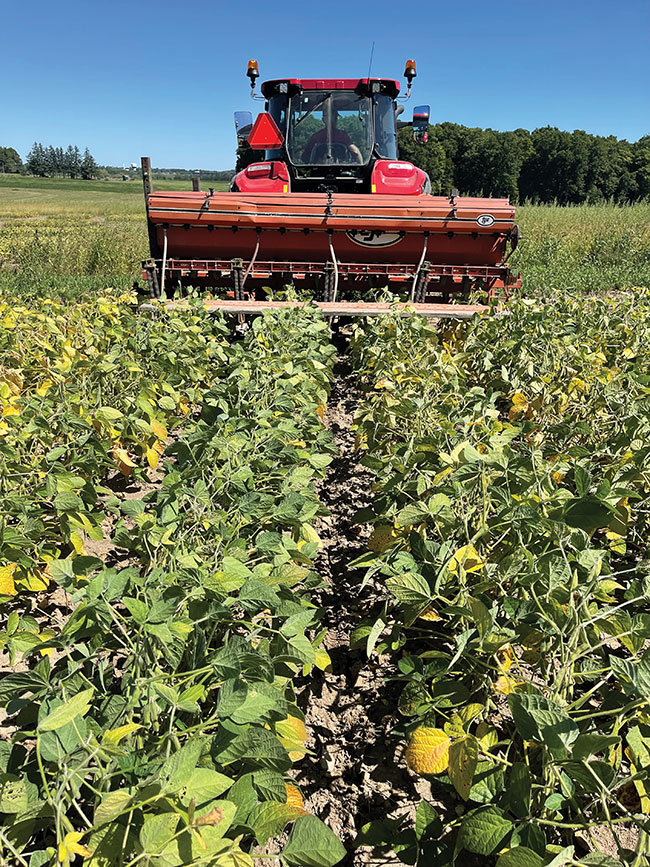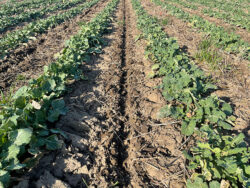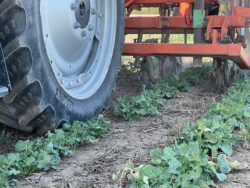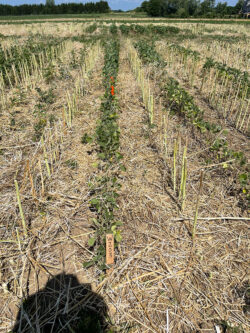
Features
Canola
Soybeans
Teaming up two high-value oilseed crops
Could winter canola and soybean be a successful pair for relay intercropping?
May 29, 2023 By Carolyn King
 Seeding winter canola into standing soybeans
Photo courtesy of Marinda DeGier, University of Guelph.
Seeding winter canola into standing soybeans
Photo courtesy of Marinda DeGier, University of Guelph. Relay intercropping systems offer the possibility of multiple soil health and economic benefits – as well as multiple challenges in figuring out to optimize production of both crops. Some growers are trying winter cereal-soybean relay intercrops in southwestern Ontario. Now, a project is underway to see if winter canola-soybean relays could work in this region.
“Relay intercropping with winter canola has never been studied in Ontario before. So, in this project, we are starting with the basic agronomics to try and see what would make it successful,” explains Marinda DeGier, a University of Guelph master’s student who is conducting this project.
One of DeGier’s co-advisors is Eric Page, who is the project’s principal investigator and an Agriculture and Agri-Food Canada (AAFC) research scientist at the Harrow Research and Development Centre. Her other co-advisor is François Tardif, a professor in the University of Guelph’s department of plant agriculture.
Page’s research interests include winter canola as well as alternative cropping systems, like double cropping and relay intercropping. In double cropping, a winter annual crop is harvested, and then a summer crop is immediately planted for harvesting in that same growing season. In relay intercropping, the second crop of the relay is planted into the living first crop. The two crops grow alongside each other until the first crop is harvested. Then the second crop grows to maturity and is harvested.
“Growers are interested in growing winter canola [because it is a high-value crop with a high yield potential]. But they might be struggling with how to make it work in their rotations. Relay intercropping with soybeans might be a way to do that,” says DeGier.
“Down south [in places like Essex County], some growers might be double-cropping soybeans after winter canola. However, double cropping isn’t always possible in areas like Elora and Woodstock because of the shorter growing season. This project is working towards figuring out if relay intercropping would be possible in such areas.”
Relay pros and cons
Both relay intercropping and double cropping are strategies aimed at harvesting two crops in the same year, adding diversity into a crop rotation and providing a living soil cover during the fall, winter and early spring.

A drilled soybean row between two winter canola rows
Photo courtesy of Marinda DeGier, University of Guelph.
In terms of soil health, relay intercropping might be even more beneficial than double cropping. “A relay intercrop system provides year-round cover with continual living roots. Not many systems outside of a perennial crop can accomplish this,” notes Page.
He explains that the continual presence of living roots means continuity for the soil microbiome. It also contributes to greater scavenging of excess nutrients in the shoulder seasons and winter, which lowers the risk of nutrient leaching. As well, it reduces soil erosion risk.
Compared to single-crop systems, relay intercropping could enhance per acre productivity. Page explains, “It is assumed that neither crop in the relay will be as productive as the same species grown in a single-crop system. Rather, the potential for increased profitability lies in the ability to harvest two crops in one calendar year.”
Relay intercropping can also be a way to hedge your bets compared to a single-crop system. He says, “If one crop is less productive, the other can potentially make up for it.”
DeGier adds, “Water- and nutrient-uptake patterns for the two species in the intercrop will peak at different points during the growing season. This may be a pro or con depending on the season, but it spreads the risk.” Also, differences in root architecture between the two crops may mean that they take up nutrients and moisture from different parts of the soil profile.
Relay systems also allow planting of the second crop at about the same time as that crop would be planted in a single-crop system. That has advantages compared to the later planting date typically needed in a double-crop system.
For instance, in a relay intercrop where soybean is the second crop, the grower could use a longer season, higher yield-potential variety. DeGier gives another example: “In the spring, we typically have adequate moisture for seeding relay soybeans, whereas in mid-summer the top inch or two of the soil may be depleted of moisture, causing issues with the germination of double-crop soybeans.”

Planting soybeans between the winter canola rows using a tractor with narrow tires.
Photo courtesy of Mike Cowbrough, OMAFRA.
However, if the growing season is long enough to allow double cropping, then double cropping may be preferable to relay intercropping, notes Page. Although double cropping has to take into account some overlapping requirements of the two crops, such as herbicide sensitivities, it avoids the complications of managing the two crops simultaneously.
Those complications include the potential for mechanical damage to one crop or the other during planting and harvesting operations, and the need to consider both crops at once regarding things like row spacing, herbicide sensitivities and fertility.
“Striking the balance between the needs of both crops in an intercrop is a challenge,” says Page. “It requires time, patience and experimentation by the farmer. Equipment availability and the capacity for spacing modification and control of seeding rates can limit implementation.”
According to Page, turning relay intercropping’s presumed benefits into actual benefits requires a long-term vision and commitment to the practice by the farmer.
Assessing two relays
DeGier’s project has two parts: a forward relay, and a reverse relay.
In the forward relay, winter canola is planted in late August/early September, and then soybeans are planted between the winter canola rows the following spring. The canola is harvested in July, and the soybeans are harvested in September/October.

Relay soybeans after the winter canola has been harvested
Photo courtesy of Marinda DeGier, University of Guelph.
In the reverse relay, the soybeans are planted in May. Then the winter canola is planted into the soybeans in late August/early September. The soybeans come off in late September/October, and then the winter canola is harvested in July of the following year.
DeGier points out that both relays have living crops in the field for longer than 12 months. Depending on the weather and the location, the forward relay’s complete cycle is around 13 months and the reverse relay’s is around 14 months.
The forward relay study is looking at two factors. One is winter canola seeding rates, with treatments comparing two-thirds of the recommended rate versus one-third. The other is spring nitrogen fertilizer rates for winter canola, with treatments comparing 50 per cent of the recommended rate versus no spring nitrogen fertilizer.
“By reducing the seeding rate and the nitrogen rate, we’re trying to manipulate the winter canola canopy to also allow for the success of the soybeans. If we had applied the standard seeding rate and the full amount of nitrogen, then the canola would likely choke out the soybeans,” explains DeGier. “We’re trying to find a balance in the relay intercrop system.”
The reverse relay study is comparing an early, middle and late planting date for winter canola. Within each of those planting dates is a comparison of drilling versus broadcasting of the canola seed.
The fieldwork, which started in September 2021, is taking place at four sites: Woodstock and Elora, managed by DeGier; and Harrow and Woodslee, managed by AAFC-Harrow staff.
The winter canola variety at all sites is a conventional hybrid called Mercedes – the only winter canola variety that is commercially available in Ontario at present. The soybean variety at each site is a herbicide-tolerant type with the appropriate maturity group (MG) for the growing area. Harrow and Woodslee are in the MG 3 zone, Woodstock is in the MG 1 zone, and Elora is in MG 0 zone.
Both winter canola and soybeans are planted on 30-inch row spacings, with the soybean rows and canola rows 15 inches from each other.
In the reverse relay, the soybeans are planted into tilled soil. In the forward relay, the winter canola is planted into tilled strips. “The benefit of strip tilling is that you have crop residue coverage between the canola rows, while being able to plant the canola into worked ground,” DeGier explains. It is important to plant winter canola into tilled soil because the presence of crop residues can increase the risk of slug damage to canola seedlings.
According to DeGier, the project team has put a lot of thought into ensuring that equipment operations for one relay crop do not damage the other relay crop. For instance, at the Elora and Woodstock locations, in the forward relay, they have retrofitted a seed drill so they can plant the soybeans on 30-inch centres without running over the canola rosettes. And they use narrow-wheeled tires to move between the rows in both relay systems.
The team is monitoring two complete cycles of each relay system. They are collecting data on parameters like crop yields, stand counts, plant height and the amount of light that gets through the first crop’s canopy and down to the second crop, as well as watching for disease and weed problems. They will also be determining the production costs of the two relays, as compared to single-crop soybean production.
This project is a first step in seeing if winter canola-soybean relay intercrops could be a way to improve the sustainability and profitability of Ontario cropping systems.
“How do you know if something will be successful until you try it? That’s what I want to do in this project – to look at intercropping winter canola and soybeans and see if it is possible,” says DeGier.
The project is funded by the Ontario Canola Growers Association, Grain Farmers of Ontario, and Rubisco Seeds. People helping with this project include: Meghan Moran, Mike Cowbrough and Horst Bohner with the Ontario Ministry of Agriculture, Food and Rural Affairs (OMAFRA); Josh Nasielski and Peter Smith with the University of Guelph; and Sydney Meloche and Alyssa Thibodeau with AAFC-Harrow.